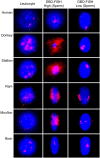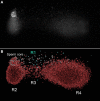Interpreting sperm DNA damage in a diverse range of mammalian sperm by means of the two-tailed comet assay
- PMID: 25505901
- PMCID: PMC4245925
- DOI: 10.3389/fgene.2014.00404
Interpreting sperm DNA damage in a diverse range of mammalian sperm by means of the two-tailed comet assay
Abstract
Key ConceptsThe two-dimensional Two-Tailed Comet assay (TT-comet) protocol is a valuable technique to differentiate between single-stranded (SSBs) and double-stranded DNA breaks (DSBs) on the same sperm cell.Protein lysis inherent with the TT-comet protocol accounts for differences in sperm protamine composition at a species-specific level to produce reliable visualization of sperm DNA damage.Alkaline treatment may break the sugar-phosphate backbone in abasic sites or at sites with deoxyribose damage, transforming these lesions into DNA breaks that are also converted into ssDNA. These lesions are known as Alkali Labile Sites "ALSs."DBD-FISH permits the in situ visualization of DNA breaks, abasic sites or alkaline-sensitive DNA regions.The alkaline comet single assay reveals that all mammalian species display constitutive ALS related with the requirement of the sperm to undergo transient changes in DNA structure linked with chromatin packing.Sperm DNA damage is associated with fertilization failure, impaired pre-and post- embryo implantation and poor pregnancy outcome.The TT is a valuable tool for identifying SSBs or DSBs in sperm cells with DNA fragmentation and can be therefore used for the purposes of fertility assessment. Sperm DNA damage is associated with fertilization failure, impaired pre-and post- embryo implantation and poor pregnancy outcome. A series of methodologies to assess DNA damage in spermatozoa have been developed but most are unable to differentiate between single-stranded DNA breaks (SSBs) and double-stranded DNA breaks (DSBs) on the same sperm cell. The two-dimensional Two-Tailed Comet assay (TT-comet) protocol highlighted in this review overcomes this limitation and emphasizes the importance in accounting for the difference in sperm protamine composition at a species-specific level for the appropriate preparation of the assay. The TT-comet is a modification of the original comet assay that uses a two dimensional electrophoresis to allow for the simultaneous evaluation of DSBs and SSBs in mammalian spermatozoa. Here we have compiled a retrospective overview of how the TT-comet assay has been used to investigate the structure and function of sperm DNA across a diverse range of mammalian species (eutheria, metatheria, and prototheria). When conducted as part of the TT-comet assay, we illustrate (a) how the alkaline comet single assay has been used to help understand the constitutive and transient changes in DNA structure associated with chromatin packing, (b) the capacity of the TT-comet to differentiate between the presence of SSBs and DSBs (c) and the possible implications of SSBs or DSBs for the assessment of infertility.
Keywords: Sperm DNA damage; eutheria; fertility; male factor; mammalian reproduction; metatheria; prototheria.
Figures







Similar articles
-
Two-Tailed Comet Assay (2T-Comet): Simultaneous Detection of DNA Single and Double Strand Breaks.Methods Mol Biol. 2017;1560:285-293. doi: 10.1007/978-1-4939-6788-9_22. Methods Mol Biol. 2017. PMID: 28155163
-
Evidence that single-stranded DNA breaks are a normal feature of koala sperm chromatin, while double-stranded DNA breaks are indicative of DNA damage.Reproduction. 2009 Aug;138(2):267-78. doi: 10.1530/REP-09-0021. Epub 2009 Jun 3. Reproduction. 2009. PMID: 19494045
-
The Impact of Single- and Double-Strand DNA Breaks in Human Spermatozoa on Assisted Reproduction.Int J Mol Sci. 2020 May 29;21(11):3882. doi: 10.3390/ijms21113882. Int J Mol Sci. 2020. PMID: 32485940 Free PMC article. Review.
-
DNA fragmentation of human spermatozoa: Simple assessment of single- and double-strand DNA breaks and their respective dynamic behavioral response.Andrology. 2020 Sep;8(5):1287-1303. doi: 10.1111/andr.12819. Epub 2020 Jun 15. Andrology. 2020. PMID: 32416007
-
Application of the comet assay for the evaluation of DNA damage in mature sperm.Mutat Res Rev Mutat Res. 2021 Jul-Dec;788:108398. doi: 10.1016/j.mrrev.2021.108398. Epub 2021 Nov 9. Mutat Res Rev Mutat Res. 2021. PMID: 34893163 Review.
Cited by
-
Sperm DNA Fragmentation: Unraveling Its Imperative Impact on Male Infertility Based on Recent Evidence.Int J Mol Sci. 2024 Sep 22;25(18):10167. doi: 10.3390/ijms251810167. Int J Mol Sci. 2024. PMID: 39337652 Free PMC article. Review.
-
Innovative technology for evaluation of sperm DNA double-strand breaks diagnoses male factor infertility and prevents reproductive failures.Sci Rep. 2023 Nov 3;13(1):18996. doi: 10.1038/s41598-023-46049-4. Sci Rep. 2023. PMID: 37923811 Free PMC article.
-
DNA fragmentation in epididymal freeze-dried ram spermatozoa impairs embryo development.J Reprod Dev. 2018 Oct 12;64(5):393-400. doi: 10.1262/jrd.2018-033. Epub 2018 Jul 5. J Reprod Dev. 2018. PMID: 29973438 Free PMC article.
-
DNA Damage Analysis in Children with Non-syndromic Developmental Delay by Comet Assay.J Clin Diagn Res. 2016 May;10(5):AC06-8. doi: 10.7860/JCDR/2016/19578.7806. Epub 2016 May 1. J Clin Diagn Res. 2016. PMID: 27437200 Free PMC article.
-
Technical Aspects and Clinical Limitations of Sperm DNA Fragmentation Testing in Male Infertility: A Global Survey, Current Guidelines, and Expert Recommendations.World J Mens Health. 2024 Jan;42(1):202-215. doi: 10.5534/wjmh.230076. Epub 2023 Aug 24. World J Mens Health. 2024. PMID: 37635341 Free PMC article.
References
Publication types
LinkOut - more resources
Full Text Sources
Other Literature Sources
Miscellaneous

